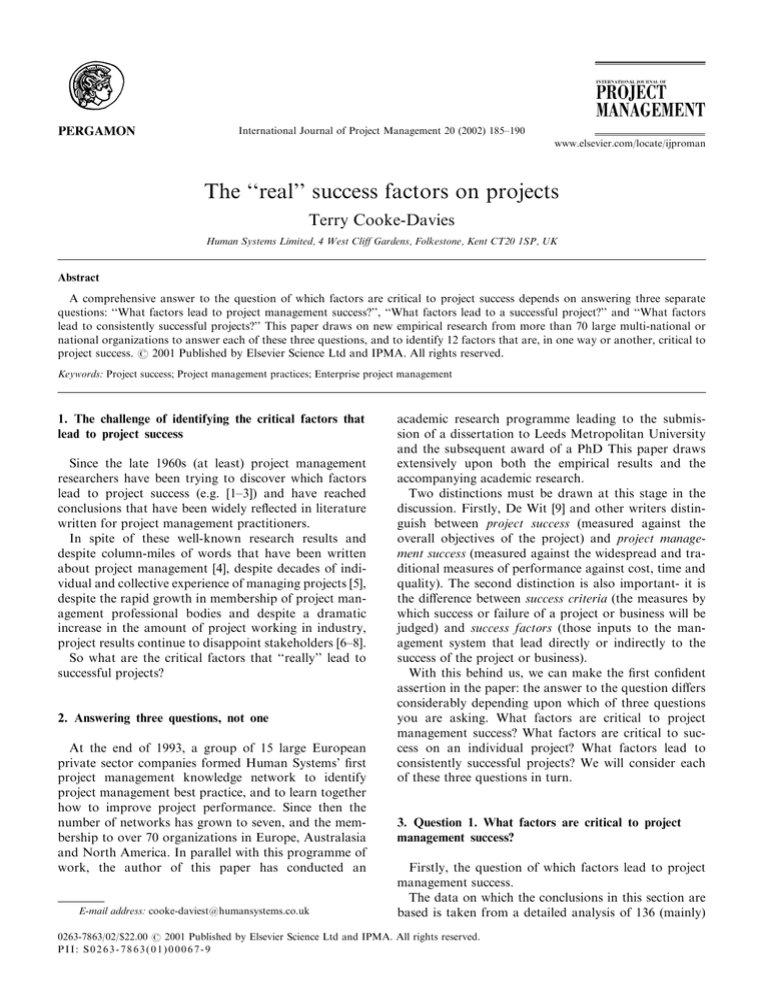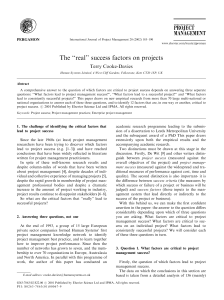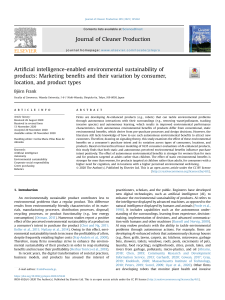
International Journal of Project Management 20 (2002) 185–190
www.elsevier.com/locate/ijproman
The ‘‘real’’ success factors on projects
Terry Cooke-Davies
Human Systems Limited, 4 West Cliff Gardens, Folkestone, Kent CT20 1SP, UK
Abstract
A comprehensive answer to the question of which factors are critical to project success depends on answering three separate
questions: ‘‘What factors lead to project management success?’’, ‘‘What factors lead to a successful project?’’ and ‘‘What factors
lead to consistently successful projects?’’ This paper draws on new empirical research from more than 70 large multi-national or
national organizations to answer each of these three questions, and to identify 12 factors that are, in one way or another, critical to
project success. # 2001 Published by Elsevier Science Ltd and IPMA. All rights reserved.
Keywords: Project success; Project management practices; Enterprise project management
1. The challenge of identifying the critical factors that
lead to project success
Since the late 1960s (at least) project management
researchers have been trying to discover which factors
lead to project success (e.g. [1–3]) and have reached
conclusions that have been widely reflected in literature
written for project management practitioners.
In spite of these well-known research results and
despite column-miles of words that have been written
about project management [4], despite decades of individual and collective experience of managing projects [5],
despite the rapid growth in membership of project management professional bodies and despite a dramatic
increase in the amount of project working in industry,
project results continue to disappoint stakeholders [6–8].
So what are the critical factors that ‘‘really’’ lead to
successful projects?
2. Answering three questions, not one
At the end of 1993, a group of 15 large European
private sector companies formed Human Systems’ first
project management knowledge network to identify
project management best practice, and to learn together
how to improve project performance. Since then the
number of networks has grown to seven, and the membership to over 70 organizations in Europe, Australasia
and North America. In parallel with this programme of
work, the author of this paper has conducted an
E-mail address: cooke-daviest@humansystems.co.uk
academic research programme leading to the submission of a dissertation to Leeds Metropolitan University
and the subsequent award of a PhD This paper draws
extensively upon both the empirical results and the
accompanying academic research.
Two distinctions must be drawn at this stage in the
discussion. Firstly, De Wit [9] and other writers distinguish between project success (measured against the
overall objectives of the project) and project management success (measured against the widespread and traditional measures of performance against cost, time and
quality). The second distinction is also important- it is
the difference between success criteria (the measures by
which success or failure of a project or business will be
judged) and success factors (those inputs to the management system that lead directly or indirectly to the
success of the project or business).
With this behind us, we can make the first confident
assertion in the paper: the answer to the question differs
considerably depending upon which of three questions
you are asking. What factors are critical to project
management success? What factors are critical to success on an individual project? What factors lead to
consistently successful projects? We will consider each
of these three questions in turn.
3. Question 1. What factors are critical to project
management success?
Firstly, the question of which factors lead to project
management success.
The data on which the conclusions in this section are
based is taken from a detailed analysis of 136 (mainly)
0263-7863/02/$22.00 # 2001 Published by Elsevier Science Ltd and IPMA. All rights reserved.
PII: S0263-7863(01)00067-9
186
T. Cooke-Davies / International Journal of Project Management 20 (2002) 185–190
European projects that were executed between 1994 and
2000 by a total of 23 organizations. The projects ranged
up to over $300 million cost and 10 years duration, with
an average of $16 million and 2 years, and a median of
$2 million and 18 months. Full details of the projects
and the analysis are contained in [8].
The first surprise thrown up by the analysis was that
when schedule delay and cost escalation were compared
for individual projects there was the expected strong
correlation between the two, but only a small amount of
the cost escalation was accounted for by schedule delay.
This is illustrated in Fig. 1, where each point on the
graph represents one of the projects and its performance against schedule (on the x axis) and budget (on
the y axis).
Two observations can be made about this phenomenon: firstly, mean performance against budget (4%
cost escalation) is generally better than mean performance against schedule (16% late); and secondly, when
the adequacy of specific project management practices,
and the maturity of specific project management processes are compared with performance against each of
these two criteria, then different practices are found to
correlate significantly.
These practices that correlate to on-time performance
are:
F1
F2
F3
F4
F5
Adequacy of company-wide education on the
concepts of risk management.
Maturity of an organisation’s processes for
assigning ownership of risks.
Adequacy with which a visible risk register is
maintained.
Adequacy of an up-to-date risk management plan.
Adequacy of documentation of organisational
responsibilities on the project.
Fig. 1. Relationship between cost predictability and time predictability.
F6
Keep project (or project stage duration) as far
below 3 years as possible (1 year is better).
On the other hand, those that correlate to on-cost
performance are:
F7
F8
Allow changes to scope only through a mature
scope change control process.
Maintain the integrity of the performance
measurement baseline.
In each of these cases, there is a significant measurable improvement in project success against the specific
criterion, as is shown in the example in Fig. 2. In this,
the time predictability is shown on the vertical axis as a
multiple of the forecast duration (i.e. 1.5 means 50%
late). Each vertical bar represents the range of outcomes
for which there exists a confidence of 95%, and the four
numbers on the horizontal axis show the result for F5
when the practice is ‘‘not at all adequate’’ (1) through to
‘‘fully adequate’’ (4). Similar patterns were recorded for
each of the factors F4–F11.
There was also a visible correlation between the predictability of outturn of the range of projects within a
particular organization, depending on the strength of
the overall group of success factors F1 to F8.
4. Question 2. What factors are critical to success on
an individual project?
As has already been pointed out, project management
success is not the same as project success. To bridge this
divide, it is necessary to bring into play the interests of
those who established the project (the stakeholders) and
what it was that they hoped to achieve through the
project (the benefits). An analysis of six recent project
management ‘‘bodies of knowledge’’ identified 60 core
elements that are central to the way a project manager
thinks about his or her work [8]. When these are clustered into eleven topic areas, and related to each
other through a ‘‘systemigram’’, it becomes clear that
‘‘anticipated benefits’’ become the touchstone not only
for formal ‘‘stage gate’’ reviews of projects, but also for
the continuous ‘‘informal assessment’’ of the likely success of projects carried out by senior management, and
influencing decisions about priorities and resource
allocation.
Comparison of the eleven topic areas with previously
published research about project success factors reveals
a silence about ‘‘benefits’’, perhaps because little has
been written about benefits management or benefits
realization until recently, and perhaps because the
T. Cooke-Davies / International Journal of Project Management 20 (2002) 185–190
187
Fig. 2. Improved project success with improving adequacy of factor F5.
Fig. 3. The importance of project management and operations management working together to deliver beneficial change from projects.
subject of ‘‘benefits’’ has been subsumed in the general
discussion about ‘‘project purpose’’ or ‘‘project goals’’.
Two things need to be said about this recognition of
the importance of benefits management:
1. As Fig. 3 shows, benefits are not delivered or realised by the project manager and project team,
they require the actions of operations management. This calls for a close co-operation between
the project team on the one hand and the ‘‘sponsor’’ or ‘‘customer’’ on the other.
2. Delivering project success is necessarily more difficult than delivering project management success,
because it inevitably involves ‘‘second order control’’ (both goals and methods liable to change)
whereas the latter involves only first order control
(hold goals constant, and change practices to meet
pre-determined goals).
Thus, in addition to the eight factors that are critical
to project management success, a ninth is critical to
project success:
188
F9
T. Cooke-Davies / International Journal of Project Management 20 (2002) 185–190
The existence of an effective benefits delivery and
management process that involves the mutual
co-operation of project management and line
management functions.
is difficult to make significant progress, and which
appear to be critical to consistent corporate success.
These are:
F10
5. Question 3. What factors lead to consistently successful projects?
As we move from project management success,
through project success to corporate success, a completely new set of processes and practices comes into the
picture as being determinate of consistently successful
projects. The fact is that the ‘‘processes and decisions to
translate strategy into programmes and projects’’ that
were referred to in Fig. 3, become, in practice, a suite of
‘‘corporate project management practices’’ that in turn
create the context for the management practices on
individual practices, as is shown diagrammatically in
Fig. 4.
Every year, each member of the knowledge networks
completes a detailed questionnaire about project management practices at both the corporate level, and the
individual project level, and thus members have a general idea about what organizations around the world do
well and what needs improving. The majority of members of the networks have achieved well-defined processes and methods for their mainstream projects in one
or more of the departments, and these are normally
followed. Standard life cycles with ‘‘stage gates’’ at predefined decision points are common.
However, the current state of practice in large organizations is showing three areas of practice in which it
F11
Portfolio- and programme management
practices that allow the enterprise to resource
fully a suite of projects that are thoughtfully
and dynamically matched to the corporate
strategy and business objectives.
A suite of project, programme and portfolio
metrics that provides direct ‘‘line of sight’’
feedback on current project performance, and
anticipated future success, so that project,
portfolio and corporate decisions can be aligned.
Since corporations are increasingly recognizing
the need for ‘‘upstream’’ measures of
‘‘downstream’’ financial success through the
adoption of reporting against such devices as
the ‘‘balanced scorecard’’ [10], it is essential for
a similar set of metrics to be developed for
project performance in those areas where a
proven link exists between project success and
corporate success. For the project management
community, it is also important to make the
distinction between project success (which
cannot be measured until after the project
is completed) and project performance (which
can be measured during the life of the project).
No system of project metrics is complete
without both sets of measures (performance
and success) and a means of linking them so
as to assess the accuracy with which
performance predicts success.
Fig. 4. The corporate context for project success.
T. Cooke-Davies / International Journal of Project Management 20 (2002) 185–190
F12
An effective means of ‘‘learning from
experience’’ on projects, that combines explicit
knowledge with tacit knowledge in a way that
encourages people to learn and to embed that
learning into continuous improvement of
project management processes and practices.
Indeed, for Kerzner [11], continuous
improvement represents the fifth and highest
stage of project management maturity in
an organization.
6. How project success and corporate success are linked
Project management literature is generally silent on
the topic of corporate success, although the 1990s have
seen an increasing emphasis on the role that projects
play in bringing about beneficial change to an organization [12–14]. However, different kinds of projects
undertaken by members of the knowledge networks
illustrate clearly that both direct and indirect links exist
between project success and corporate success.
6.1. General corporate strategy
. Successful Business Process Reengineering projects
(which have a notoriously low rate of achievement
of their objectives) can lead directly to improved
competitiveness.
. Successful corporate restructuring or merger/
acquisition projects can lead directly to enhanced
shareholder value.
6.2. Business operations
. If the business is essentially project-based (as is the
case in many of the traditional project management environments such as Engineering, Defence,
Petrochemical exploration, Construction or IT/IS
Systems Integration) then successful project performance translates directly into an improved
bottom-line.
. If the business is operations-based, then successful
projects to support or to improve operations (such
as marketing projects, plant shutdowns, or production engineering projects) lead indirectly to
improved bottom-line performance.
6.3. Research and development
. Successful research projects and (in the case of
some industries such as Pharmaceuticals) develop-
189
ment projects lead to a maximised return on R&D
spend, leading directly to the creation of new
streams of operating revenue.
. Successful development projects improve time to
market, and can enhance competitive position,
product sales or product margins.
6.4. IT/IS development
. Successful IT/IS projects deliver improved
financial benefits (either directly or indirectly),
and/or reduced wastage from aborted projects
(Standish [7]).
6.5. Facilities provision and management
. Successful projects to design, procure and construct new capital assets can enhance time to market, return on investment, reduced operating costs
or some combination of all three.
This list is not exhaustive, but what all these and
other types of project have in common, when successful, is that each of them contributes to the creation of
additional corporate value—and sustained long-term
value-creation is the ultimate measure of corporate
success.
7. The ‘‘people’’ side of project management
The 12 ‘‘real’’ success factors for projects have all
been derived from either ‘‘hard’’ data (F1–F8) or from
‘‘softer’’ evidence (F9–F12). They are all factors that
have been implemented, or are being implemented, in
large multi-national or national organizations.
It may appear curious that none of these 12 critical
success factors is directly concerned with ‘‘human factors’’, although it is fast becoming accepted wisdom that
it is people who deliver projects, not processes and systems. As [3] said in the title of his paper, ‘‘When it
comes to project management, it’s the people that
count.’’
There are two reasons that we would like to suggest
for this strange omission. Firstly, the research on which
this paper is largely based has focused on what people
and teams do, rather than on the quality of their human
interactions or motivation and decision-making practices. Secondly, there are human dimensions to nearly
every one of the 12 factors that have been identified. It
is not as if there are some factors that involve processes,
and others that involve people—people perform every
process, and it is the people who ultimately determine
the adequacy. Thus the ‘‘people’’ side of the success
factors is woven into their very fabric.
190
T. Cooke-Davies / International Journal of Project Management 20 (2002) 185–190
References
[1] Baker BN, Murphy DC, Fisher D. Factors affecting project success. In: Cleland DI, King WR, editors. Project management
handbook. (2nd ed.). New York: John Wiley, 1988.
[2] Pinto JK, Slevin DP. Critical success factors across the project
life cycle. Project Management Journal 1988;19(3):67–75.
[3] Lechler T. 1998. When it comes to project management, it’s the
people that matter: an empirical analysis of project management
in germany. In: Hartman, F., Jergeas, G., Thomas, J. editors.
IRNOP III. The nature and role of projects in the next 20 years:
research issues and problems. Calgary University of Calgary. pp.
205–15
[4] Kloppenborg TJ, Opfer WA. Forty years of project management
research: trends, interpretations and predictions. Proceedings of
PMI research conference paris project management institute.
Paris: Project Management Institute, 2000.
[5] Morris PWG. The management of projects. London: Thomas
Telford, 1994.
[6] O’Connor MM, Reinsborough L. Quality projects in the 1990s: a
[7]
[8]
[9]
[10]
[11]
[12]
[13]
[14]
review of past projects and future trends. International Journal of
Project Management 1992;10(2):107–14.
Standish Group. 1995. Chaos. Available: http://standishgroup.com/
visitor/chaos.htm.
Cooke-Davies TJ. 2000. Towards improved project management
practice, PhD thesis, Leeds Metropolitan University.
De Wit A. Measurement of project success. International Journal
of Project Management 1988;6.
Kaplan RS, Norton DP. The balanced scorecard. Translating
strategy into action. Cambridge, Mass.: Harvard Business School
Press, 1996.
Kerzner H. Applied project management. Best practices on
implementation. New York: John Wiley, 2000.
Gareis R. Handbook of management by projects. Vienna: Manz,
1990.
Turner JR. The handbook of project-based management. England: McGraw-Hill, 1993.
Dinsmore P. Winning in business through enterprise project
management. New York: American Management Association,
1999.





